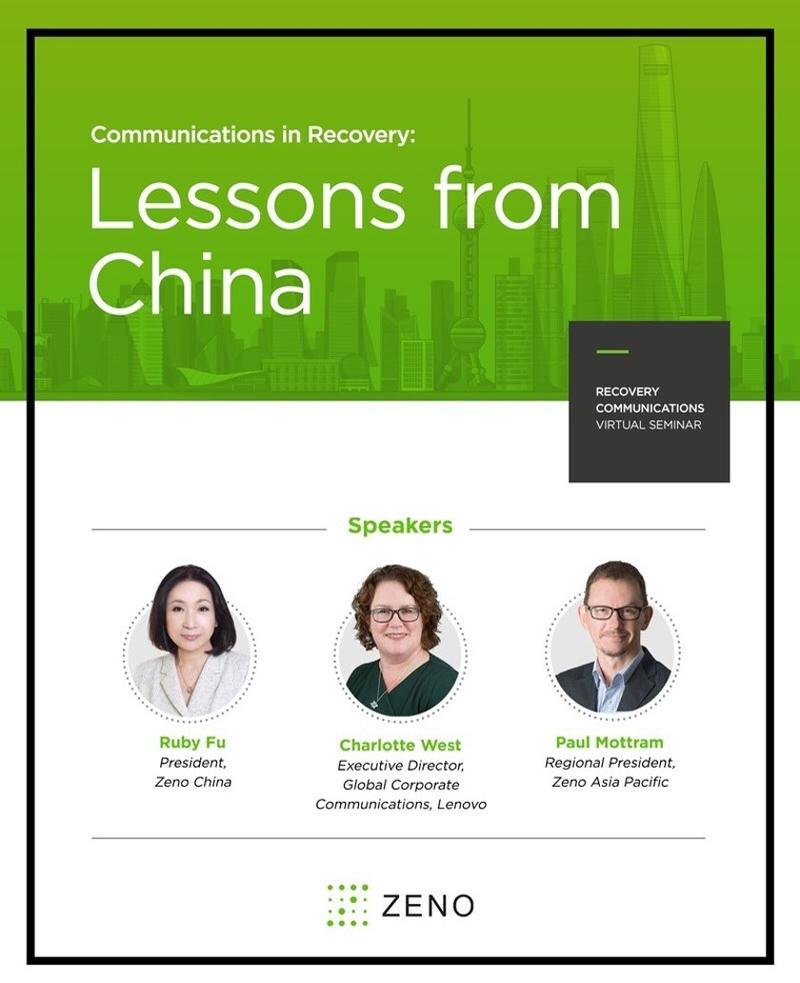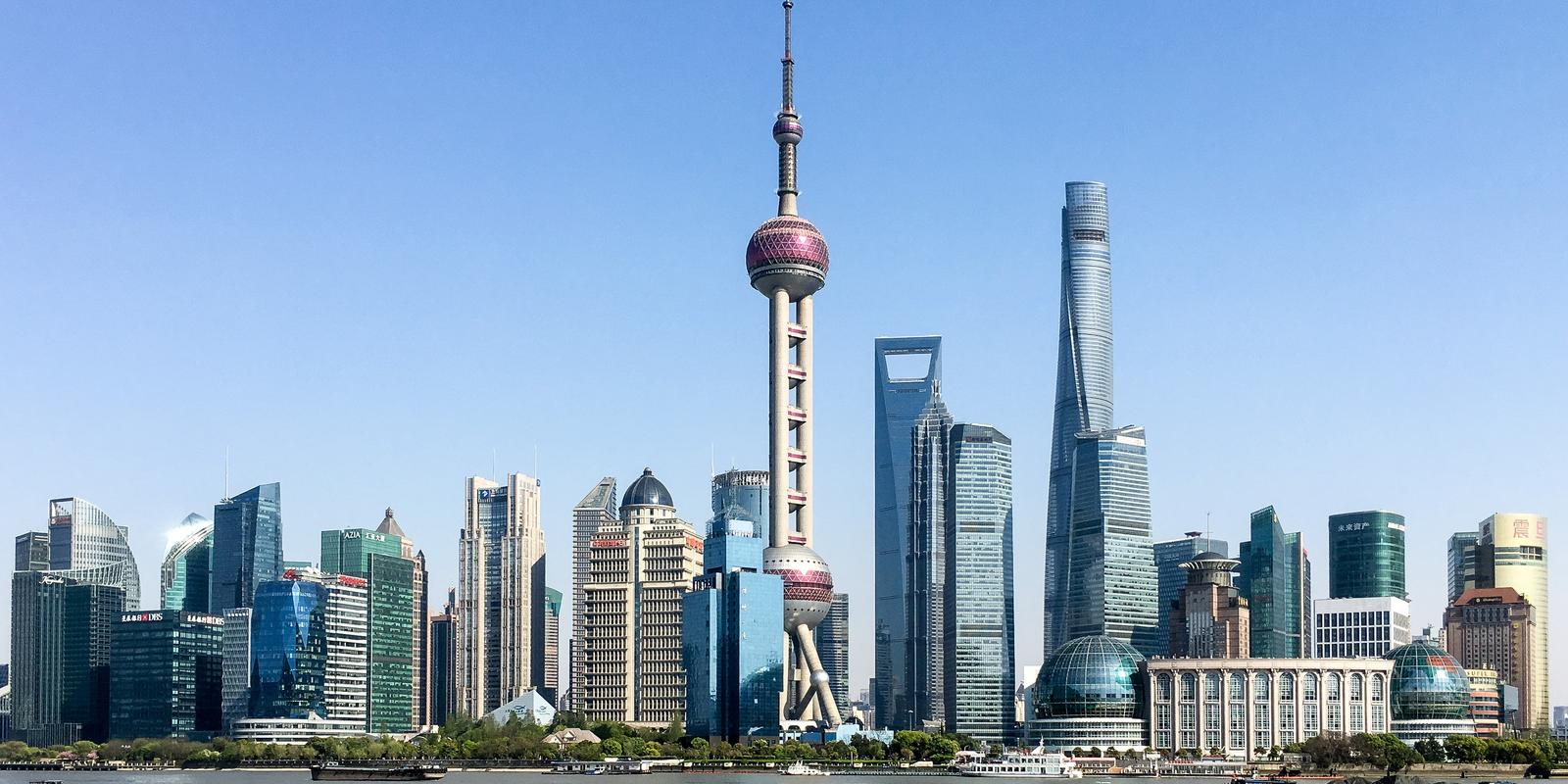
Recovery Communications Lessons from China
By Ruby Fu
06/25/20

As COVID-19 remains as the single biggest issue across the globe, with its impact growing and far-reaching to all corners of the world, Zeno Group initiated an online seminar to discuss its influence on people, business and social behavior. The role of communications was also discussed – how it has evolved as an important element to business and lives than ever before. Presented through the lens of China’s communications approach to the pandemic, attendees received a first-hand view of how the very first market hit by the crisis has responded and navigating its current phase of recovery. This, along with select Chinese enterprise case studies, unveiled a number of lessons and actionable insights for other markets.
The seminar was hosted by Ruby Fu, President of Zeno China; Paul Mottram, Regional President of Zeno Asia Pacific; and Charlotte West, Executive Director of Lenovo Global Corporate Communications. More than 80 communications, marketing and business professionals across Asia Pacific joined the conversation.
Two Dimensions and Four Phases
When we look back from the beginning to the development stage of the crisis, it is clear that the health and economic dimensions were of paramount importance. The safety of employees and impact to business became the two biggest priorities for any company.
Observing the timeline in China, Zeno found that the evolution of COVID-19 can be divided into four phases:
- Phase 1 started with the first reported case in late January. Public sentiment was largely of denial and defiance, met with further measures and government regulations to contain the outbreak.
- Phase 2 started with the adoption of social restrictions in late February, and public health measures and economic intervention began to take effect. The timeframe is estimated to be 2
- Phase 3 started with the return to social stability and business recovery in early April, and this phase is estimated to last 3-6 months.
- Phase 4 started with the lifting of most restrictions. The focus shifts to maintaining stability, with the rest of the world following suit, permanently changing our day-to-day lifestyle entirely.
Companies need to keep listening to employees and customers, aligning with government guidelines and market developments through each phase to successfully find their own way to a new normal.
Bringing Light to Expectations Out of An Unexpected Crisis
It is difficult for companies to confront the changes in phase 1 and phase 2. In China however, leading brands such as Tencent, Alibaba, JD.com and TikTok have set some good examples in adapting to these following the below principles:
- Be quick to respond: Adapt to restrictions early, engage key stakeholders to provide solutions supported by the capabilities of the business.
- Be transparent with information: Offer information in a transparent manner, in real time and keep messages consistent.
- People come first: Establish internal workgroups and resources to accommodate your employees’ questions and requests to continue employee engagement.
- Demonstrate social responsibility: Be in tune with public sentiment and deliver key messages with empathy. This humanizes the brand and displays and ethical approach to the issue at hand.
Turn Communications and Business Activity from Reactive to Proactive
It is not enough to find the way back to normal in a reactive way. Companies need to proactively explore ways to innovate their existing business models and practices in phase 3 and phase 4. Peninsula Hotels, Gree and more FMCG brands have accelerated their proactive efforts in getting back to business in a number of key areas:
- Digital strategy: Leveraging the company’s own online channels and third-party digital tools to drive sales and create closer conversations with customers.
- Customer-oriented: Prioritizing customers’ needs by providing tangible and customized products and services.
- Brand purpose: Rethinking and evaluating the brand’s purpose and executing a ‘recovery’ campaign that aligns with brand’s authentic spirit.
- Spokesperson preparation: Identifying multiple spokespeople or subject matter experts and providing media training to help manage challenging questions.
- Tech-based communication tools: Creating a comprehensive toolkit to refresh and improve the customer experience by using virtual technology and leveraging insights from big data analysis.
Embracing The New Normal and Thinking Beyond Communication
Although we cannot predict what the new normal will be like in the next year and beyond, we can prepare to see some new trends take effect.
- New stimulus: Companies will seize the reopening of the market and look to leverage stimulus provided by the government to boost the economy.
- New retail: Companies will focus on building brand loyalty and optimize high technology in customer communication methods through direct conversation.
- New event formats: Offline events such as sports, performances and awards will shift online, from campaign warm-up to post-event social communications.
- New business models: Companies will engage a wider range of stakeholders to explore new business models and improvement of supply chains.
- New advisors: Key Opinion Consumers and Key Opinion Sales will be powerful influencers despite the driving force of traditional Key Opinion Leaders.
Communications is leading an important and essential role during COVID-19 to drive business and manage customer communications. The new normal is beyond communications and sales tactics and has a deeper, lasting influence in our professional and personal lives. COVID-19 should inspire companies to rethink their purpose in gaining trust amongst stakeholders and to be a thought leader in key aspects of how the pandemic has changed the world entirely.

Published on June 25, 2020.
